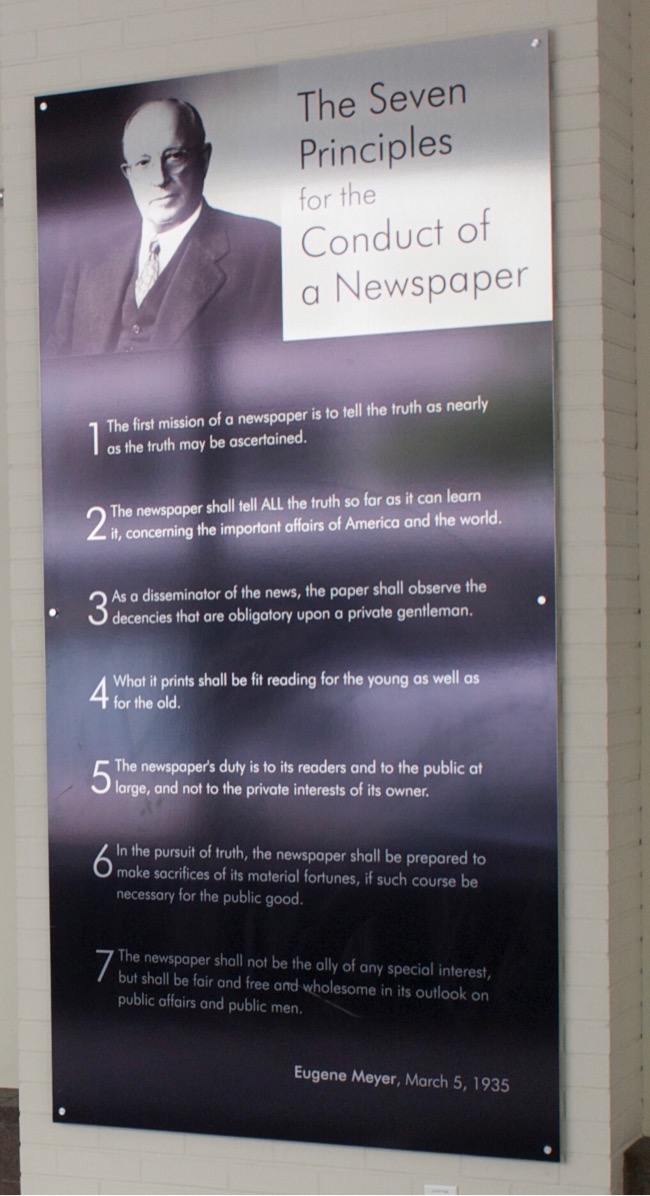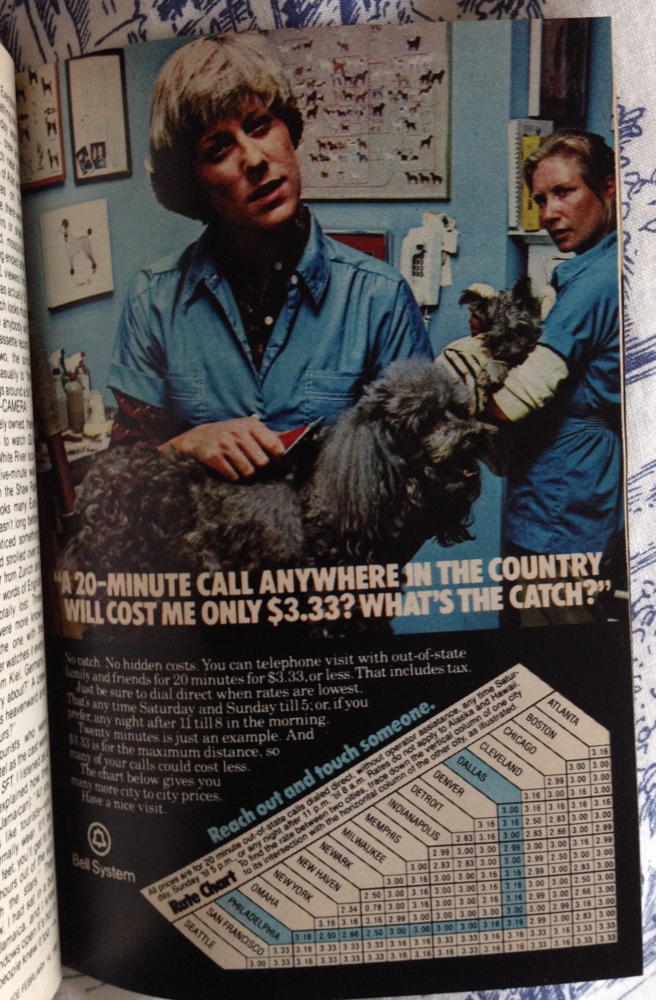2016 in photos
- August 24, 2016: An outdated code of conduct
-
A few years ago, researching a novel, I visited Washington DC. Since the novel is about swashbuckling journalists, I of course entered the lobby of the Washington Post. At the entrance is part of an old printing press, and this code of conduct for the press. I understand that the Post has since moved to another building; I expect they sent the code to a museum in the move, because every item on this list that isn’t outdated has been ignored for decades.
The Seven Principles for the Conduct of a Newspaper
- The first mission of a newspaper is to tell the truth as nearly as the truth may be ascertained.
- The newspaper shall tell all the truth so far as it can learn it, concerning the important affairs of America and the world.
- As a disseminator of the news, the paper shall observe the decencies that are obligatory upon a private gentleman.
- What it prints shall be fit reading for the young as well as for the old.
- The newspaper’s duty is to its readers and to the public at large, and not to the private interests of its owner.
- In the pursuit of truth, the newspaper shall be prepared to make sacrifices of its material fortunes, if such course be necessary for the public good.
- The newspaper shall not be the ally of any special interest, but shall be fair and free and wholesome in its outlook on public affairs and public men.
Eugene Meyer, March 5, 1935
Eugene Meyer founded the Post—I learned this from David Halberstam’s gigantic The Powers That Be. Meyer bought it in bankruptcy and built it into the powerful newspaper it is today, before handing it (and his daughter, Katherine) over to Phil Graham.
Some of the rules are still followed, if you add “in the beltway” to the end. The paper still observes the decencies that are obligatory upon a private gentleman in the beltway. That is, while scandals, and even non-scandals, about conservatives are newsworthy national news, scandals about Democrats are private affairs, local news at best.
- August 10, 2016: Natural monopolies: a 20-minute call for $8.83
-
A few years ago, I received an old TV Guide from 1981 as a gift. There were a lot of fun things in it, such as Bosom Buddies, giant murals of flying horses through rainbows, the sort of stuff you expect from the late seventies and early eighties.
There was also this ad from AT&T’s “Bell System” touting the incredibly low price of $3.33 per twenty minutes. In 1981, AT&T had a monopoly on phone service. That $3.33 per 20 minutes is, according to the Bureau of Labor Statistics inflation calculator, $8.83 per 20 minutes, or $26.49 per hour.
And read the fine print: that’s just the off-hours cost.
That’s any time Saturday and Sunday till 5; or, if you prefer, any night after 11 till 8 in the morning.
Today, even on AT&T, you only pay $1.40 per 20 minutes1, and you don’t have to worry about peak vs. off-peak hours. That’s if you still have a land-line. More likely, if you have a cell phone, you don’t even worry about minutes anymore.
I remember having to time my long-distance calls home in order to avoid incurring the “peak rate”: calling early in the morning, usually, because my parents went to bed before 11 PM, then remembering to say goodbye before 8 AM.
You can still see the vestige of it in AT&T’s “basic rates”, which are the rates you pay if you have AT&T but for some reason you don’t have a long-distance plan. Even those are, during off-peak hours, only $3.00 per 20 minutes. That would be as if AT&T’s highest off-peak cost in 1981 were $1.13.2
AT&T was a government-sponsored monopoly. I can just barely remember when we weren’t even allowed to plug in our own phones. I remember being happy that I could find an inexpensive “Conair” telephone when I was in college, so that we could have a phone in our apartment.
- July 20, 2016: Democrats endorse public school elections, teacher recalls?
-

I recently saw an odd meme on Facebook that both illustrates the poor state of education among the left today, and suggests an interesting idea for improving public schools that does not involve vouchers. A group called “Winning Democrats” started a meme calling for treating legislators and teachers the same when it comes to measuring job performance.
Making teachers elected and recallable is an interesting idea.
Now, the group didn’t seem to realize that’s what they’re calling for. Their meme suggested devising a method for tying legislative pay to job performance:
Legislators want teachers to be paid according to their effectiveness as evaluated by student test scores.
How about paying legislators according to their job effectiveness, as evaluated by job creation and economic growth?
They don’t seem to realize that such a method already exists for legislators: elections and recalls.
Their ignorance is probably a reflection on the poor state of Civics instruction in the government-run schools they attended. But the idea is worth thinking about. Attempting to measure teacher performance is an understandable attempt to mimic a free market; but government always fails when it tries to fake a free market. Any rules put in place to pretend to be a free market end up being gamed by those taking part in the system, usually the administrators on both ends of the system. We saw this in California’s power exchanges, we see it today in the federal insurance exchanges, and we see it in all of the corruption attendant in trying to hold government schools accountable for the education they provide.
In a sane school system, parents of children who were not being served well by one school would simply take their children to another school. Teachers who failed to serve students well would be out of a job, or relegated to less remunerative non-teaching roles; any school that retained poor teachers would go out of business. This, of course, already happens in private schools, but because most people can’t afford to pay twice for their children’s education most parents cannot use private schools.
For most parents, there is only one option for school just as there is only one option for government: the government-run school that their tax dollars pay for.
- May 11, 2016: Dr. Frank N. Furter: the left’s answer to transgender bathrooms
-
Rarely has there been a less self-aware meme than this one. It shows two real child molesters who molested young girls, and then a photo of Dr. Frank N. Furter from The Rocky Horror Picture Show and the caption “Not a child molester”. And the left uses it as an argument in favor of letting all three into bathrooms, pretending that the first two will self-segregate themselves from taking advantage of the new policies, and that the third is the hated target of those who oppose men in women’s restrooms.
It’s an almost perfect encapsulation of the left’s argument style. First, Tim Curry’s character in Rocky Horror almost certainly was a child molester. We just didn’t see it on screen because there were no children in the movie. But according to the song, Eddie went straight from Teddy Bears to threatening his father with a switchblade to having sex with Furter; it isn’t unlikely that Eddie was underage when Furter started having sex with him. And Furter, who was hell-bent on sex with everyone, everything, and at all times, regardless of consent, would almost certainly have tried to have sex with children had there been any in the movie.1
But even assuming that Furter’s initial dealings with Eddie were all above board2, and that Furter would have respected the boundaries of any children he met in an isolated location, Furter raped Brad and Janet, he murdered Eddie, and then he served Eddie for dinner.
Dr. Frank N. Furter shouldn’t just be kept out of women’s bathrooms. He should be kept off of earth.3 He’s not a good spokesperson for transgenders unless the left defines transgenders as murderous, cannibalistic rapists.4
- May 7, 2016: Model 100 from 1916
-
Good old Microsoft and their apocalyptic view that we would never reach the year 2000!
I just acquired this old Model 100 and it works pretty well. I love the address book and scheduler. They are literally just text files, edited using the word processor function, and searched using a simple search tool.
There is a lot to be said for text.
More 2016
- 2017 in Photos
- For photos, memes, and perhaps other quick notes sent from my mobile device or written on the fly during 2017.
More Live Blog
- 2020 in Photos
- For photos, memes, and perhaps other quick notes sent from my mobile device or written on the fly during 2020.
- 2019 in Photos
- For photos, memes, and perhaps other quick notes sent from my mobile device or written on the fly during 2019.
- 2018 in Photos
- For photos, memes, and perhaps other quick notes sent from my mobile device or written on the fly during 2018.
- 2017 in Photos
- For photos, memes, and perhaps other quick notes sent from my mobile device or written on the fly during 2017.
- 2015 in photos
- For photos and perhaps other quick notes sent from my mobile device or written on the fly during 2015.
- Five more pages with the topic Live Blog, and other related pages




